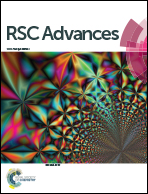High quantum-yield luminescent MoS2 quantum dots with variable light emission created via direct ultrasonic exfoliation of MoS2 nanosheets†
Abstract
We report a sonication combined with ion intercalation method in an alkaline environment to fabricate MoS2 quantum dots (QDs), with the quantum-yield of the QDs increasing from 0.99% to 4.84% with the additive sodium hydroxide. The QDs displaying variable photoluminescence emission were systematically studied and applied to the bio-imaging field.


 Please wait while we load your content...
Please wait while we load your content...